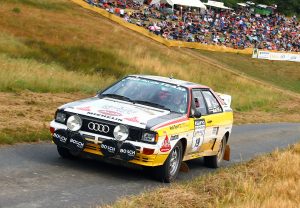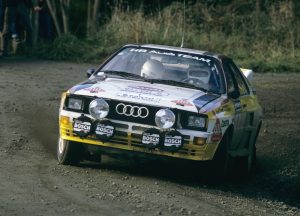Heute: Jürgen Reeb/Uwe Mayer, Deutschland
Bei diesem Audi Quattro A2 handelt es sich um einen von 2011 bis 2013 entstandenen Nachbau. Jürgen Reeb hat damit an der Deutschland Classic 2013 erstmals teilgenommen. Im Winter 2023-2024 wurde der Audi noch einmal komplett überarbeitet und in vielen Details originaler gestaltet.
Gestern: Walter Röhrl/Christian Geistdörfer, Rallye Neuseeland 1984
Walter musste den Quattro bei dieser Rallye aufgrund von Elektrikproblemen in Führung liegend abstellen. Nach der Rückkehr in Ingolstadt lief der Quattro wieder als wäre nie etwas gewesen. Wem die Bezeichnung A2 nichts sagt, dem sei Folgendes erklärt: Zur Saison 1983 homologierte Audi für den Quattro einen leichteren Motorblock aus Aluminium, der Anfangsbuchstabe sorgte für das Kürzel A in A1. Der Hubraum blieb wie beim Ur-Quattro bei 2144 ccm. Zum 1. Mai 1983 wurde dann der Quattro A2 homologiert, dessen Motor nur noch 2109 ccm hatte. Damit fiel er trotz des Turbokoeffizienten von 1,4 in die Gewichtsklasse von unter drei Liter Hubraum und durfte unter 1000 kg wiegen.
Today: Jürgen Reeb/Uwe Mayer, Germany
It took Jürgen Reeb two years (2011 to 2013) to build this Audi Quattro A2 rally car. After the restoration, it was displayed on several events in Europe and also used on the 2013 edition of the Deutschland Classic. In the winter of 2023-2024, the Audi was completely redesigned again and made more original in many details.
Yesterday: Walter Röhrl/Christian Geistdörfer, New Zealand Rally 1984
Walter Röhrl was leading the 1984 Rally of New Zealand when his Audi Quattro A2 had to retire due to electrical problems. But for some strange reason the car was running nicely again after its return to Ingolstadt and all problems seemed to have cured themselves. For those who always wondered what the designation A2 meant: For 1983, Audi homologated a new and lighter aluminium engine which was named as the A1 (the A standing for aluminium). While the cylinder capacity stayed at 2144 cc for the A1, it was reduced to 2109 cc for the Quattro A2 which was homologated on May 1st, 1983. The reduction in cylinder capacity meant that – after applying the turbo coefficient of 1.4 – the Quattro now had a nominal capacity of 2952 cc and thus could run with a weight of less than 1000 kg.
Aujourd’hui : Jürgen Reeb/Uwe Meyer, Allemagne
Il a fallu à Jürgen Reeb deux ans (2011-2013) pour construire cette voiture de rallye Audi Quattro A2. Après la restauration, il a été montrée sur plusieurs événements en Europe et également utilisée durant l’édition 2013 du Deutschland classique. Au cours de l’hiver 2023-2024, l’Audi a été une nouvelle fois entièrement revue et de nombreux détails ont été rendus plus originaux.
Hier : Walter Röhrl/Christian Geistdörfer, Rallye de Nouvelle Zélande 1984
Walter Röhrl menait le Rallye de Nouvelle-Zélande 1984 lorsque son Audi Quattro A2 a dû abandonner en raison de problèmes électriques. Mais pour une raison étrange la voiture fonctionnait bien à nouveau après son retour à Ingolstadt et tous les problèmes semblait être réglés. Pour ceux qui se sont toujours demandé ce que signifiait la désignation A2: En 1983, Audi homologue un nouveau moteur en aluminium et plus léger qui a été nommé l’A1 (A pour aluminium). Alors que la cylindrée est resté à 2144 cm3 pour l’A1, elle a été réduite à 2109 cc pour la Quattro A2 qui a été homologuée le 1er mai 1983, la réduction de la cylindrée permettait près application du coefficient de turbo de 1,4 que la Quattro ait une capacité nominale de 2952 cc et pouvait donc courir avec un poids de moins de 1000 kg.






